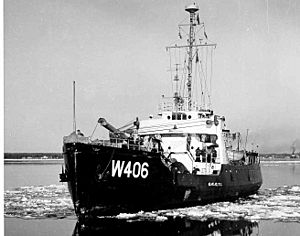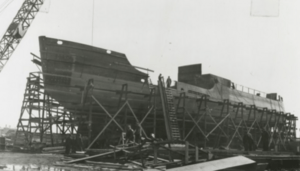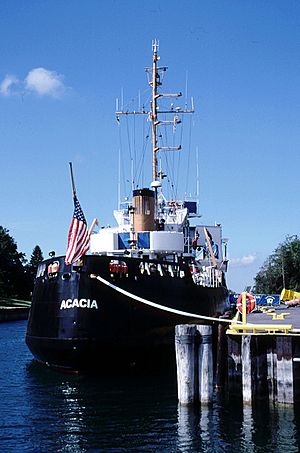USCGC Acacia (WLB-406) facts for kids

USCGC Acacia in 1944
|
|
Quick facts for kids History |
|
|---|---|
| Builder | Zenith Dredge Company, Duluth, Minnesota |
| Cost | $927,156 |
| Laid down | 16 January 1944 |
| Launched | 7 April 1944 |
| Commissioned | 1 September 1944 |
| Decommissioned | 7 June 2006 |
| Identification |
|
| Motto | Ace Of The Lakes |
| Status | Museum ship |
| General characteristics as built in 1944 | |
| Class and type | Iris |
| Displacement | 935 tons |
| Length | 180 ft (55 m) |
| Beam | 37 ft (11 m) |
| Draft | 12 feet (3.7 m) |
| Propulsion | 2 Cooper-Bessemer GND-8 Diesel engines |
| Speed | 14 kn (26 km/h; 16 mph) maximum |
| Range | 8,000 nmi (15,000 km; 9,200 mi) at 13 kn (24 km/h; 15 mph) |
| Complement | 6 officers, 74 enlisted men |
| Armament |
|
The USCGC Acacia (WAGL-406/WLB-406) was a special ship that served in the United States Coast Guard. It was a 180-foot seagoing buoy tender, which means its main job was to take care of buoys. Buoys are floating markers that guide ships safely through the water.
But the Acacia was a multi-purpose ship. It could also break through ice, perform search and rescue missions, and help with fire fighting and oil spills. The ship spent nearly all of its 62-year career on the Great Lakes. After it was retired, it became a museum ship in Manistee, Michigan, where people can visit it today.
Contents
Building a Tough Ship
The Acacia was built in Duluth, Minnesota, during World War II. Construction started on January 16, 1944, and the ship was ready for service on September 1, 1944. It was one of 39 similar ships built for the Coast Guard.
Strong and Powerful Design
The ship's body, or hull, was made of strong steel plates. It was 180 feet (55 m) long and 37 feet (11 m) wide. The Acacia was specially designed for breaking ice. It had a thick band of steel around its waterline, called an "ice belt," to protect it from being damaged by ice. Its bow (the front of the ship) was shaped to ride up onto the ice and crush it with the ship's weight.
The Acacia was powered by a diesel-electric system. Two large diesel engines created electricity, which then powered an electric motor that turned the ship's single propeller. This system gave it the power needed for tough jobs like icebreaking.
The ship also had a large crane on its deck that could lift up to 20 tons. This was used to lift heavy buoys out of the water for repairs.
Weapons and Crew
During World War II, the Acacia was armed with a large 3-inch gun and two smaller 20mm guns. This was allowed under a special agreement with Canada. After the war, the big guns were removed because of a treaty that limited weapons on the Great Lakes. Later, machine guns were added to help with law enforcement and to protect the country's borders.
When it was first built, the ship had a crew of 6 officers and 74 enlisted men. Over the years, as technology improved, the crew size was reduced.
The ship was originally going to be named Thistle. However, the U.S. Army already had a ship with that name. So, the Coast Guard named it Acacia instead. This was to honor an earlier Coast Guard ship of the same name that was sunk during World War II.
A Career on the Great Lakes
The Acacia's first home port was Detroit, Michigan. Its work changed with the seasons on the Great Lakes.
Working with Buoys and Ice
In the fall, the Acacia would collect buoys from the water. This was to stop them from being damaged or lost when the lakes froze over. In one ten-day period, it collected about 150 buoys. Over the winter, the crew would clean, repair, and repaint the buoys. In the spring, the Acacia would put them all back in the water.
Icebreaking was another key mission. The ship would clear paths for other vessels and free ships that got stuck in the ice. For example, in 1945, it quickly freed a large freighter that was trapped in Lake Erie ice. This work was important for keeping shipping routes open, especially for ships carrying coal to power plants in Detroit.
Search and Rescue Missions
The Acacia was often called to help in emergencies. In 1951, it helped save a freighter that was flooding after a collision. In 1966, after the freighter Daniel J. Morrell sank in a storm on Lake Huron, the Acacia searched for survivors and recovered the bodies of eight crew members. In another rescue in 1971, the crew saved 16 people from a sinking ship.
New Homes and Big Upgrades
In 1958, the Acacia's home port moved to Port Huron, Michigan. Its mission stayed the same, but it was now responsible for 145 buoys in a new area.
In 1975, the ship sailed to a shipyard in Maryland for a major upgrade. The engines were overhauled, and new electrical systems were installed. The crew's living spaces were modernized, and a new bow thruster was added. This device made the ship much easier to handle in tight spaces. The total cost of this renovation was over $9 million.
After the upgrade, Acacia was sent to a new home port in Sturgeon Bay, Wisconsin, in 1976. A few years later, in 1979, it moved again to Grand Haven, Michigan. From there, it continued to care for 220 buoys all across Lake Michigan.
Later Years of Service
In the winter of 1987, the Acacia was sent to the warm waters of the Caribbean Sea. There, it helped a group of 88 people from Haiti on a small boat, returning them safely to their home country. The ship also assisted in stopping two people who were breaking the law.
In 1990, the Acacia moved to its final home port in Charlevoix, Michigan. This move happened after another Coast Guard cutter, the USCGC Mesquite, ran aground and was lost in Lake Superior. The Acacia had helped try to save the Mesquite and contain an oil spill from the damaged ship.
In 1994, the Acacia was called to the Caribbean again. This time, it was to help during a crisis in Haiti. The ship's crew surveyed and placed buoys in major ports to help the U.S. military operation there. For this work, the ship and its crew earned the Armed Forces Expeditionary Medal.
The USCGC Acacia was decommissioned, or retired from service, on June 7, 2006. It was the very last of the 180-foot buoy tenders to be retired, ending a long and successful career.
Life as a Museum Ship
After being retired, the Acacia was given to a non-profit group that wanted to turn it into a museum in Chicago. However, they could not find a good place to dock the ship there.
In 2009, the ship was transferred to another group in Manistee, Michigan. On October 16, 2009, the Acacia sailed under its own power one last time to Manistee. There, it became part of the SS City of Milwaukee National Historic Landmark museum. Today, the Acacia is open to the public, allowing visitors to explore a real Coast Guard cutter and learn about its amazing history on the Great Lakes.



